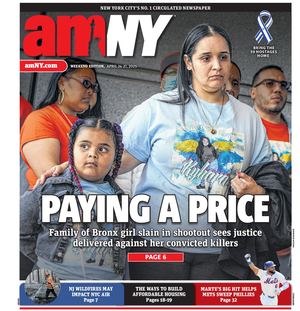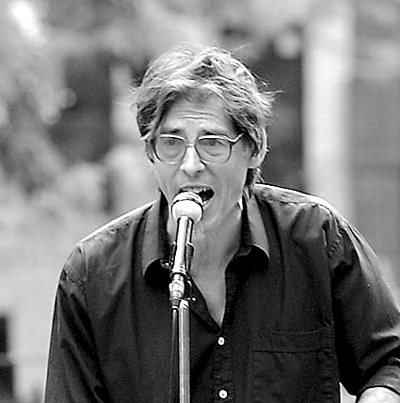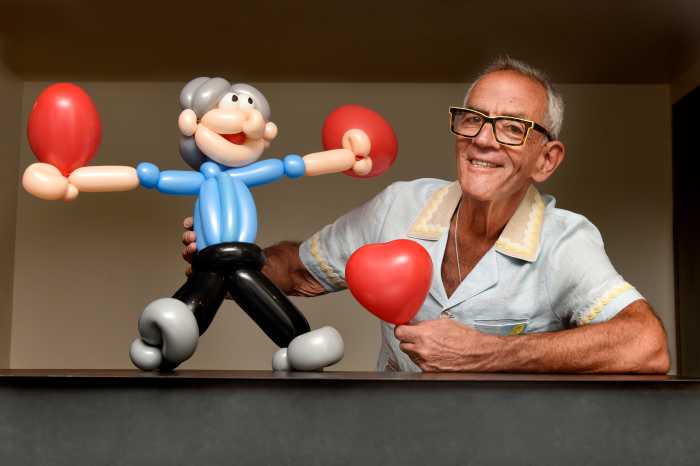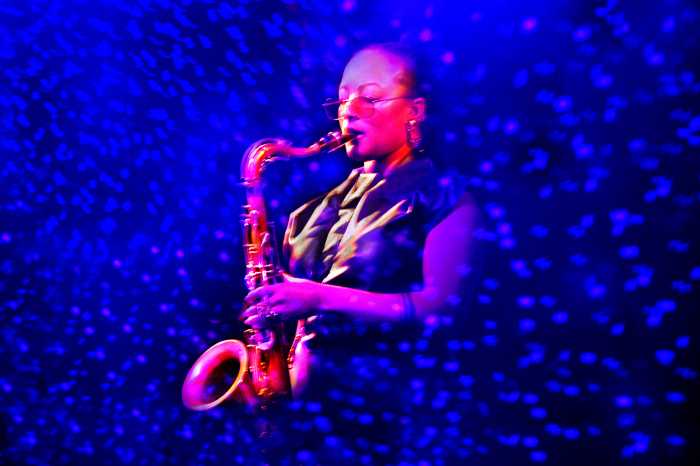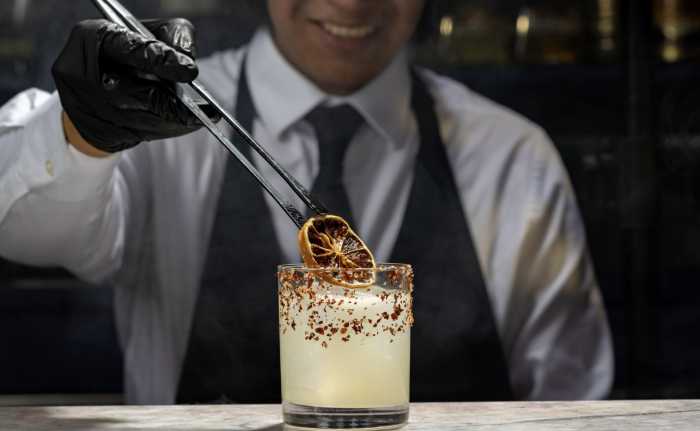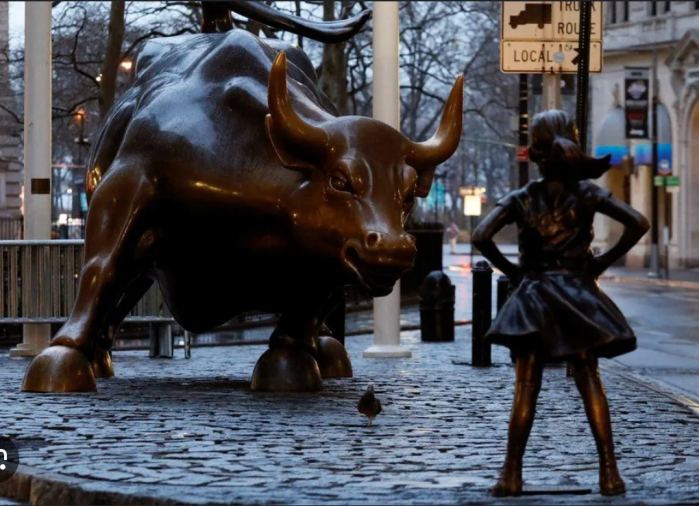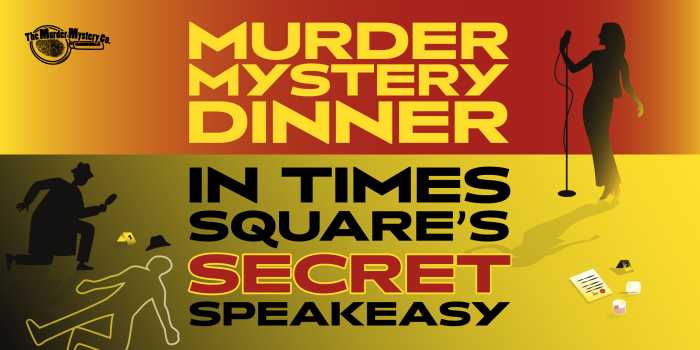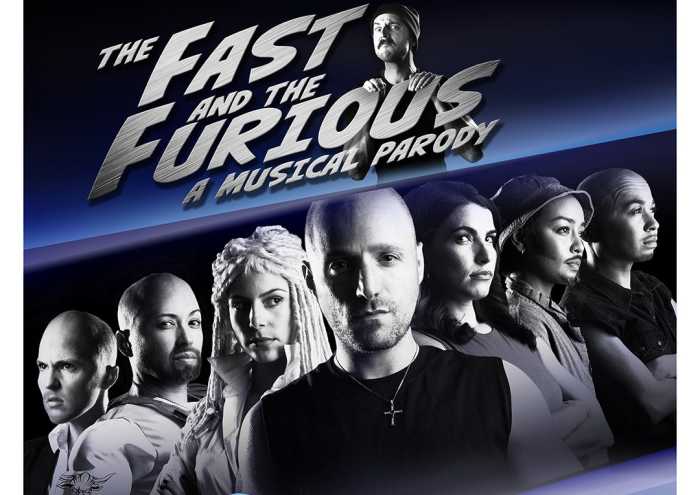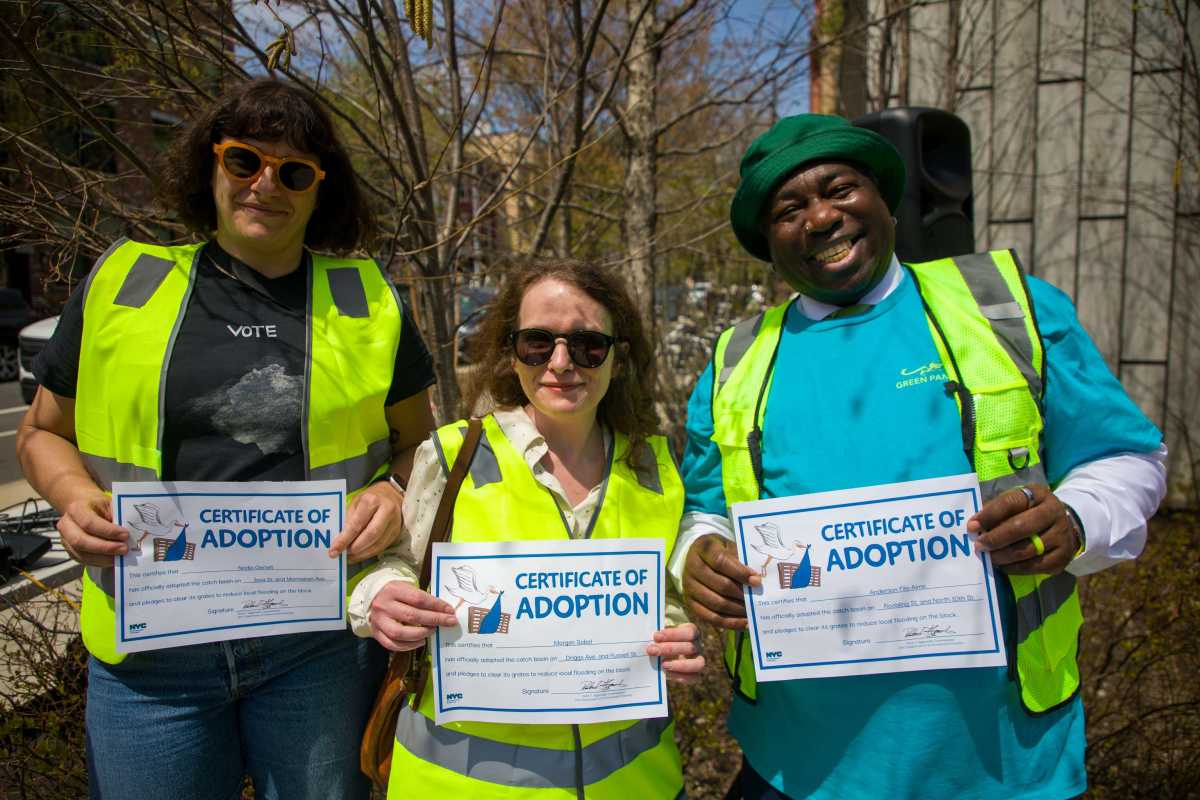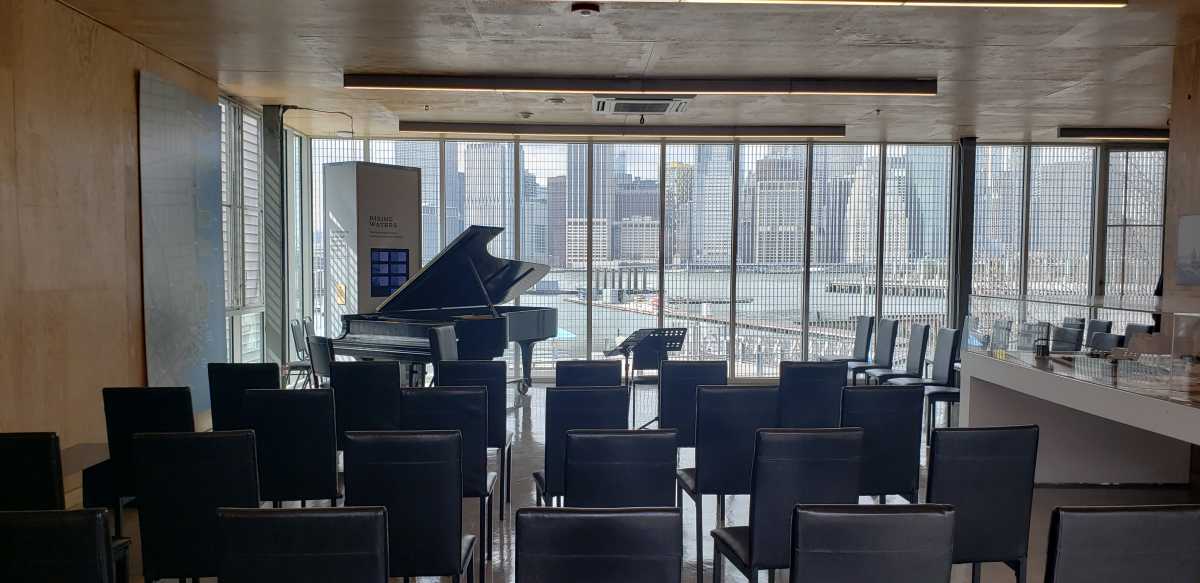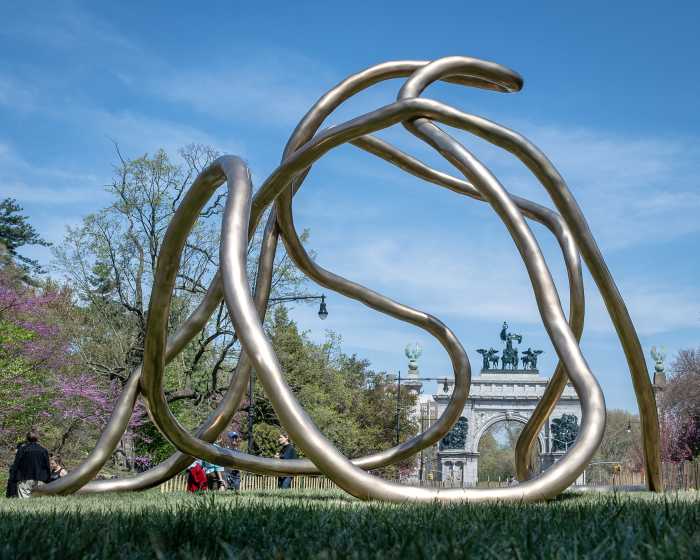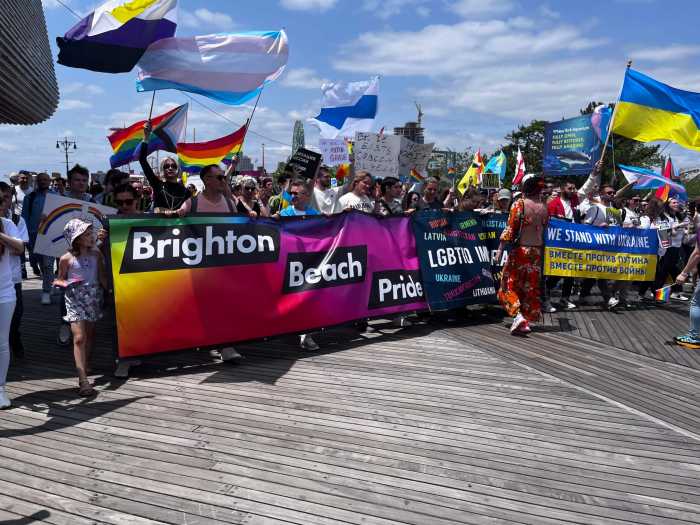By Lincoln Anderson
When police were trying to barge into St. Mark’s Church-in-the-Bowery on Aug. 27 to arrest bicyclists from Critical Mass seeking refuge inside, one man stood in the entranceway blocking them. Father Frank Morales told the officers they couldn’t come in, that the church was a place of sanctuary. They respected his request — though that didn’t stop them from arresting scores of bike riders outside on Second Ave.
“The police were vamping on the bikers,” Morales said. “We were not going to stand by. When you stand by you become an abuser.”
It was Morales who was in large part responsible for allowing the historically liberal East Village church and its grounds to become “Protesters Central” during the Republican National Convention this summer. Others who helped coordinate the protesters’ use of the church were performance artist preacher Reverend Billy; his wife, Savitri Durkee; and Tom Torn, son of actor Rip.
Morales modestly said they simply allowed the young activists access to the space.
“What was manifested there was an alternative vision of how we can organize ourselves,” he said. “They were feeding 500 meals a day. They were educating each other. They had a medical tent. We just had the keys and put out some ideas. But people came and made it. I thought it was a beautiful, beautiful thing.”
Morales was speaking at the church on Nov. 3, after a meeting of a small group of local anarchists, socialists, radicals and just plain neighbors. They had needed to talk and commiserate after Bush’s demoralizing victory and Morales — again — had opened the church for them.
A dignified and striking figure, dressed all in black, with a small silver goatee, Morales has been an associate pastor at the church about four years. His presence is helping transform it into even more of a center of activism than before.
Although he’s well known in the neighborhood, for reasons he himself can’t explain, intrigue — and sometimes controversy — seem to attach themselves to him.
“I know, there’s an air of mystery that surrounds me. I have no idea,” he said. “People like to project. Maybe they’re bored with their lives.”
So who is Frank Morales? For starters, he isn’t a newcomer to the neighborhood. In fact, he grew up in it.
His life story would make a good novel or movie. There are distinct chapters: gifted student makes good, child of the ’60s, rock singer, Kennedy/King assassination investigator, socially conscious priest, squatter organizer and, the latest, anti-police-state activist.
During an interview at Life Cafe at Avenue B and 10th St., just down the block from the squat — or technically former squat — he lives in, and not much farther from where he was raised, he filled in the picture.
Morales was born in 1949 and grew up in the Jacob Riis Houses at 12th St. and Avenue D. His father was Puerto Rican and worked as a porter at the Jewish Home and Hospital for the Aged on W. 106th St., becoming a union shop steward. His mother was from Peru; her father was an Italian in the merchant marine and her mother native Peruvian. He has two younger sisters.
The East Village of the ’50s and ’60s, “pre-drugs,” as Morales recalls it, was ethnically mixed, working class, all in all, an ideal place to grow up. Neighbors in his building were black, Jewish, Cherokee and Puerto Rican.
“I think the neighborhood was actually more diverse than it became,” he said. “There was some violence, but it was a pretty stable neighborhood from a psychological point of view.”
Morales was a member of a gang, the D Boys, but being a good speaker — “I wore glasses from third grade on, I was smart,” he noted — his main role was “information minister.”
“Speed was big in those days,” Morales recalled. He was fast. He used to sprint home from the Boys’ Club to avoid another gang that hung out by Tompkins Sq. “Right on that corner,” he said, over a bowl of soup, nodding across the street.
Street games were also huge: stickball, ringolevio, skelly, manhunt.
“At my peak, I could hit a bottle cap from 10 ft. away,” Morales said of his skills in skelly, a sort of miniature bocce played on a 13-box grid.
A good student, he was perennial co-president of his P.S. 34 elementary school class.
Morales and some of his Riis Houses buddies were in the first Boys’ Club educational program and thanks to it he was able to attend private Cushing Academy in Massachusetts from grades 7 to 12.
“It was a bit of a culture shock because I grew up on Avenue D,” he said. “So I ran away a few times — once made it to the Port Authority. Charlie, this Polish guy from the Boys’ Club, came and got me.” But he eventually settled in, earning high honors in his second term, realizing he could hack it.
“You got this rep,” he recalled. “I was the first scholarship kid that they’d had at the school — quote, unquote ‘poor kid.’ I didn’t have to do much. They paid me some kind of respect.”
Shortly after Morales arrived at Cushing in 1963, John F. Kennedy was assassinated. It profoundly affected the young Lower East Sider — as did the subsequent killings of Robert Kennedy and Martin Luther King. Morales would later become part of a group called the Assassination Information Committee.
“I spent a couple of years in the 1970s on the assassination circuit,” he said. “They were all cover-ups.”
For example, Morales thinks Sirhan Sirhan, still in jail for R.F.K.’s murder, is innocent.
“He was a decoy. He was cued by the woman in the polka dot dress,” Morales explained.
Morales says Zack Sklar, the scriptwriter for Oliver Stone’s “J.F.K.,” conferred with him while working on the film. Morales said a nervous Sklar didn’t want to meet at Odessa restaurant on Avenue A, so they had to meet him Upstate.
It’s clear to Morales that the gunfire that killed J.F.K. didn’t come from Lee Harvey Oswald in the book depository but from the grassy knoll. In the famous amateur Zapruder film of the shooting, “Everyone’s pointing in one direction,” the knoll, Morales noted.
Sixties music was new and exciting, and in high school and college Morales was in bands. In his first band, The Raves, he sang backup. They performed at Cafe Wha on MacDougal St., where Jimi Hendrix was playing in the Blue Flames, a soul band. They’d hang out in the club sometimes between shows.
“When they weren’t playing, he’d work on his own things — I remember ‘Wind Cries Mary,’ ” Morales said. “He was striking. No black person had an Afro at that point. And his clothing was so outlandish. He had layers of clothes — like a T-shirt with eyes and another T-shirt over it with cutouts for the eyes.”
Forerunners of the hippies were settling in the East Village. Morales recalls the “witches stores” that used to be on Szold Pl. near Riis Houses. And there was a “Digger house,” where acid flowed freely, on Avenue A and 10th St.
“They would dose people regularly,” he said. “They’d have a vat of Kool-Aid in front and gave out doses. They’d let people crash there. I crashed there a few times.”
By the time he was in college, first at Hobart, then Cornell, the Aquarian Age was in full bloom.
“We really did believe oppression as we knew it was over,” he said, “like the Christians in the 1st century, packing their bags for heaven…. All this music was new. Peace was in.”
Then came Robert Kennedy’s assassination.
“You talk about traumatic,” Morales said. “The World Trade Center was traumatic. But Robert Kennedy was going to be president. There were rumors that he was going to choose King for vice president. They took him out — and everybody knew…. They beheaded the counterculture — the ’60s didn’t collapse.”
While learning from a campus chaplain the steps needed to become a conscientious objector to the Vietnam War, Morales got more interested in religion.
“It became clear that the New Testament is a revolutionary ideology,” Morales said. It’s an ideology that President Bush doesn’t understand, in his view.
“It’s the prince of peace we’re talking about here — duh,” noted Morales. “It doesn’t make sense to fight wars in the name of the prince of peace.”
After hitchhiking back and forth to the Haight five or six times after college, Morales entered the General Seminary in Chelsea in 1973, emerging three years later an ordained Episcopal minister. The Episcopal church’s liberalness appealed to him.
“I was raised Catholic, but it seemed a little stiff to me,” he explained. “You can’t get married, the celibacy thing — I was in rock bands.”
A new movement, Latin American liberation theology, was being born, and again Morales was right at the cusp and deeply influenced.
“God is with the oppressed,” he said. “Marxism is all right, but it’s kind of boring, very European. Jesus’ stuff is much more inflammatory. It’s much deeper.”
In 1978, Morales went to the South Bronx — then synonymous with the term “bombed out” — to become an assistant pastor.
“It was heavy,” he said. “I wanted to follow in Jesus’ footsteps, go to where poverty was.”
Morales led the construction of a park on some vacant lots and also the squatting of buildings around the park, at 139th St. and St. Ann’s Pl.
“I used to walk out of services with a crowbar and we’d open up abandoned buildings,” he recalled. “Winos and drug addicts would be knocking on my door at 7:30 in the morning saying, ‘Let’s go.’ They knocked this park out.”
In 1985, Morales returned to his old neighborhood, “primarily because I wanted to come home,” he said.
He became a leader of the squatter movement in the East Village, which had 100 abandoned buildings. Funding had stopped for the Homesteader program, under which people could legally fix up derelict buildings, then apply for ownership. Homelessness was on the rise.
Summing up his feelings about squatting, Morales said, “The only way you can get housing is to seize it. The buildings are sitting empty. People need housing. It’s fun to do this — that’s a big part of it for me. It’s fun to sweep out the debris. You can make a daycare center or community kitchen.”
Thanks to Morales’ involvement, Bishop Paul Moore and Archdeacon Michael Kendall came down to stand with the squatters against police evictions.
Evictions of the squats continued through the 1990s.
In an historic deal, in 2002 the city allowed 11 city-owned abandoned East Village buildings — home to over 200 squatters — to be purchased for $1 each by the nonprofit Urban Homesteading Assistance Board. UHAB is helping the residents renovate the buildings and bring them up to code, after which they will become limited-equity affordable co-ops owned and run by the tenants.
Morales calls the agreement with UHAB a “firewall” to protect the squats, but is concerned there will be a “rude awakening” in about two years when the squatters are left holding the check for the buildings’ extensive — he feels excessive — UHAB-led renovations. He fears some tenants could be priced out by higher rents that will result. He’s been talking to UHAB about possible subsidies to insure all the squatters can remain. The squatters won’t evict each other, he stressed.
“We took 22 buildings. We have 11 now,” Morales said. “I’m cautiously optimistic. Obviously, I would have preferred to remain totally outside the system.”
Morales noted that some squatters have mellowed as a result of raising families. He married and has children, but, fearing for his family members’ safety, didn’t want to discuss his personal life, saying threats — veiled and not-so veiled — have been made against him for his research on the military and police.
During the squatter struggles, Morales took a hiatus of sorts from the church. Now with what he calls the “normalization” and “decriminalization” of the squats, he’s found himself drawn back to his religious calling.
After Reverend Julio Torres became pastor at St. Mark’s one of the first things he did was to stop by Morales’ squat. He knocked on Morales’ door, held out a priest’s shirt and said he needed him. Morales originally met Torres, who is from El Salvador, when both were involved in liberation theology.
“I’m objective enough to know I’m not your standard priest type,” Morales said. “My role with Julio here in part is to be a bridge between the church and community — the grassroots activists and Hispanic immigrant community, working on housing and immigration rights.”
He performs weddings, though is less likely than other priests to put a prospective couple through the paces — if they love each other and seem to get along, he marries them. In the summer, he frequently subs around the diocese for priests on vacation. According to several acquaintances, Morales performed last rites for the dead at Ground Zero.
Morales’s position at the church is unpaid. He supports himself through carpentry work, a skill he picked up as a squatter, which he does when not engaged in his other occupation — research and writing on the military and police.
In an era of mass protests, Morales — like some sort of East Village leftist Zelig — is again right in the mix. Starting in the late 1990s and increasingly after 2001, he has become an expert on what he says is a new relatively unknown initiative by Washington to quell domestic dissent. The Pentagon even has a name for the 10-year-old program: O.O.T.W., or Operations Other Than War. In Morales’ view, the line separating the military from the police is being blurred, a direct violation of the Posse Comitatus Act of 1878, which bars the military from acting as a police force.
“That act is under review by the Bush administration,” he said. “There’s a very good chance it will be repealed. When you collapse the police function with the military function, that’s what you call a police state.”
Before the Republican National Convention, a group Morales co-founded, Campaign to Demilitarize the Police, tried to obtain information from the New York Police Department on what crowd-control devices and weapons would be used against the protesters and called on police not to use metal pens to corral protesters.
The police did come clean on some tactics. A New York Times article reported top brass saying they wouldn’t use a high-tech vehicle that emits sound frequencies to disorient crowds. However, responding to a “street party” protest on 16th St. near Union Sq. on Aug. 31, the N.Y.P.D. did use this vehicle, according to Morales and others. The Villager sent the Police Press Department a photo of the vehicle, which, after review, a police spokesperson described as a loudspeaker truck. Morales said it can be used as a loudspeaker truck, but its primary use is as an “acoustical weapon.”
Earlier this year, Morales and the Campaign to Demilitarize the Police protested a bill by Representative Carolyn Maloney to allow the C.I.A. and local police precincts to share information. The bill would have required changing the C.I.A.’s charter, something never before done, according to Morales.
“Carolyn Maloney was pushing a bill to embed C.I.A. officers in local police precincts,” he said. “We got her to pull the bill. We put a few people in front of her office and we zapped her e-mail. She buckled. I was sort of surprised.”
Although Maloney authored the bill, Morales is skeptical.
“She’s got a pretty liberal record,” he said. “It just doesn’t vibe as her kind of bill. But who knows?”
In response to the criticisms, Maloney began drafting a revised bill, but dropped it when the larger intelligence reform bill emerged after the 9/11 Commission’s report.
In a statement, Maloney said, “I appreciated and shared the concerns expressed by several of my constituents, including those in this group, that the well-defined missions of our current intelligence-gathering agencies should not be blurred…. [But] we cannot allow poor communication within our intelligence system to continue when we know that failures to communicate contributed to the nation’s inability to stop the 9/11 attacks in New York City.”
Morales has authored a book, “Police State America,” has written for Covert Action magazine and is a longtime contributor to the East Village anarchist newspaper, The Shadow.
Most mainstream media, however, aren’t interested in Morales’ findings. “The Times, The New Yorker, Vanity Fair — they just don’t want to touch it,” he said. He’s undeterred, though.
“The way I feel now is I have a responsibility to really stay with this material. There aren’t that many people following it,” Morales said. “My bias, and I’ll admit it, is I want to create a more favorable climate for dissent.”
Speaking of protests, Morales is a big fan of the Critical Mass rides.
“The city is continuing this vendetta against Critical Mass,” he said. “But Critical Mass — they’re feisty. They’ll triumph in the end…. I’d join them but I’m not much of a bike rider, because my vision’s not so good — I tend to lose concentration.”
Although the danger to the squats has passed, one last battle looms — the former CHARAS/El Bohio building. Some, like the East Village Community Coalition and Councilmember Margarita Lopez, are hoping a miracle will occur and the Landmarks Preservation Commission will designate the old school a landmark, blocking Gregg Singer’s mega-dorm project. Morales — who lives across the street from the site — thinks a more aggressive approach may be called for.
Singer has already applied for demolition permits to raze the back of the building for the new dorm.
“It’s going to be hard for me to stand there and watch them try to demo that place,” he said. “If it gets to the point that that’s going to happen, we have a responsibility to take a stand — and put our bodies on the line to keep that from happening.”
Morales says he’ll also continue take a stand spiritually for making the world a better, more equitable and peaceful place.
“My central value is making love real between neighbors,” he said. “People are dying because of this lack of love, it’s not abstract,” Morales said, citing last month’s John Hopkins report claiming 100,000 civilians had died in the Iraq War. “Half of those killed were women and children,” he said. “I mean, that’s an obscenity. Anyone who looks the other way on that is a far cry from any kind of moral person.
“As long as I’m here, I’m going to put my shoulder to the wheel and work with people who are serious about making love between neighbors real and building a world of justice and equality. That to me is the coolest thing. That for me is the hip thing.”
